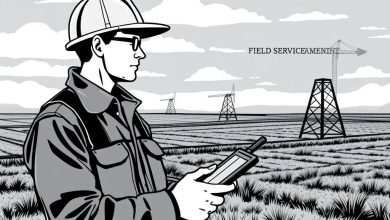Field Service Management with Resource Allocation Heatmaps

Introduction
Field Service Management (FSM) is a critical component of many industries, particularly in sectors such as telecommunications, utilities, and home maintenance. As businesses continue to grow and expand their operations, managing field services efficiently becomes increasingly challenging. One powerful tool that has emerged to address this challenge is resource allocation heatmaps.
Resource allocation heatmaps provide visual representations of available resources and their distribution across various locations or time slots. This technology has revolutionized how companies manage their field service operations, enabling them to optimize resource utilization, reduce costs, and improve customer satisfaction.
In this article, we will explore the concept of FSM with resource allocation heatmaps, its benefits, implementation strategies, and best practices for effective management.
What is Field Service Management?
Field Service Management refers to the process of planning, scheduling, and executing tasks performed outside of a traditional office environment. It involves coordinating activities such as equipment installation, maintenance, repairs, and other on-site services.
Key components of FSM include:
- Work order management
- Scheduling and dispatching
- Inventory management
- Customer relationship management
- Mobile workforce management
Effective FSM ensures that the right technician arrives at the right location at the right time, equipped with the necessary tools and information to complete the job efficiently.
The Role of Resource Allocation Heatmaps in FSM
Resource allocation heatmaps are graphical representations of available resources (e.g., technicians, vehicles, equipment) superimposed onto a geographical map. These heatmaps provide real-time visibility into resource availability and distribution across different areas or time slots.
Benefits of using resource allocation heatmaps in FSM include:
- Improved visualization of resource distribution
- Enhanced decision-making capabilities
- Optimized scheduling and routing
- Reduced travel times and costs
- Better allocation of resources based on demand patterns
How Resource Allocation Heatmaps Work
Resource allocation heatmaps typically consist of three main elements:
- A base map showing geographical locations
- Color-coded overlays representing different types of resources
- Interactive controls allowing users to filter and adjust the display
For example, a heatmap might show:
- Blue dots representing available technicians
- Red dots indicating booked appointments
- Green lines showing optimal routes between locations
Users can interact with the heatmap to:
- Zoom in/out
- Pan across different areas
- Filter resources based on criteria like skill level or vehicle type
- Adjust the time range to view future bookings
Implementation Strategies for FSM with Resource Allocation Heatmaps
Implementing FSM with resource allocation heatmaps requires careful planning and execution. Here are some key strategies to consider:
- Data Integration:
- Ensure seamless integration between FSM software and resource allocation heatmap tools
- Standardize data formats and protocols for efficient data exchange
2. Training and Adoption:
- Provide comprehensive training to field service managers and technicians on using the heatmap technology
- Encourage adoption by highlighting the benefits and demonstrating real-world examples
3. Customization:
- Tailor the heatmap display to meet specific business needs
- Customize color schemes, legend keys, and other visual elements to enhance clarity
4. Real-time Updates:
- Implement real-time synchronization of resource availability across all systems
- Automate updates based on job completions, cancellations, or technician status changes
5. Performance Metrics:
- Establish key performance indicators (KPIs) to measure the effectiveness of the heatmap system
- Regularly review and analyze these metrics to identify areas for improvement
Best Practices for Effective Management
To maximize the benefits of FSM with resource allocation heatmaps, consider the following best practices:
- Regular Maintenance:
- Keep the heatmap data up-to-date and accurate
- Conduct periodic audits to ensure data integrity
2. Continuous Improvement:
- Gather feedback from field service managers and technicians
- Use insights gained to refine scheduling algorithms and optimize resource allocation
3. Scalability:
- Choose a flexible platform that can accommodate growth in operations
- Plan for future expansion of resources and locations
4. Integration with Other Systems:
- Ensure seamless integration with CRM systems, inventory management software, and other FSM tools
- Automate data flow between systems to reduce manual input errors
5. Security and Compliance:
- Implement robust security measures to protect sensitive customer and business data
- Comply with relevant regulations such as GDPR and CCPA when handling personal information
Conclusion
Field Service Management with resource allocation heatmaps represents a significant advancement in operational efficiency for businesses providing field services. By visualizing resource distribution across geographical areas and time slots, companies can make informed decisions about scheduling, routing, and resource allocation.
As technology continues to evolve, we can expect even more sophisticated heatmap solutions to emerge. These may incorporate artificial intelligence, machine learning algorithms, and real-time predictive analytics to further optimize field service operations.
For field service managers looking to improve their operations, implementing resource allocation heatmaps should be considered a top priority. The benefits in terms of cost reduction, improved customer satisfaction, and enhanced operational efficiency make this technology an invaluable asset in today’s competitive business landscape.
By embracing this innovative approach to FSM, companies can position themselves at the forefront of efficient field service delivery, setting them apart from competitors and ensuring long-term success in their respective markets.




